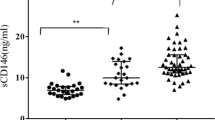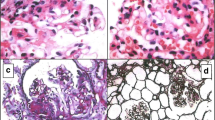Abstract
CD163 is a 130-kDa, type I transmembrane protein belonging to group B of the cysteine-rich scavenger receptor family. Expression of CD163 is constitutive and/or induced by some stimuli on circulating monocytes and most tissue macrophages. An approximately 130-kDa soluble form of human CD163 is released from the cell surface by proteolysis after oxidative stress or inflammatory stimuli. Thus, an elevated level of circulating soluble CD163 (sCD163) has been reported in diabetes mellitus, which is one of the oxidative conditions. We have already acknowledged that scleroderma (SSc) is one of the oxidative conditions. Therefore, we conducted the measurement of serum sCD163 in SSc patients. After receiving the informed consents, 56 SSc patients were examined; 20 dermatomyositis patients were used as disease controls and 40 persons were used as healthy controls. Blood samples were collected, and the concentration of serum sCD163 was measured by ELISA (human CD163, R&D Systems). Other parameters in the blood of SSc patients were also examined. Statistical analyses were performed using Mann–Whitney U test, and the relationship between parameters was statistically examined by Spearman's rank test. Serum sCD163 levels were elevated in SSc patients compared with normal controls (p < 0.01), with similar levels between limited SSc and diffuse SSc patients. SSc patients with pulmonary fibrosis had increased serum levels of sCD163 than those without pulmonary fibrosis (p < 0.05). SSc patients with elevated sCD163 levels had increased serum levels of IgG than those with normal sCD163 levels (p < 0.05). Serum sCD163 levels correlated positively with pulsatility index in SSc patients (p = 0.0009, r = 0.534). These results suggest that oxidative stress may play an important role in immunological abnormalities, renal circulation, and pulmonary fibrosis of SSc.




Similar content being viewed by others
References
Douvas AS, Achten M, Tan EM (1979) Identification of a nuclear protein (Scl-70) as a unique target of human antinuclear antibodies in scleroderma. J Biol Chem 254:10514–10522
Moroi Y, Peebles C, Fritzler MJ, Steigerwald J, Tan EM (1980) Autoantibody to centromere (kinetochore) in scleroderma sera. Proc Natl Acad Sci USA 77:1627–1631
Kuwana M, Kaburaki J, Mimori T, Tojo T, Homma M (1993) Autoantibody reactive with three classes of RNA polymerases in sera from patients with systemic sclerosis. J Clin Invest 91:1399–1404
Herrick AL, Rieley F, Schofield D, Hollis S, Braganza JM, Jayson MI (1994) Micronutrient antioxidant status in patients with primary Raynaud's phenomenon and systemic sclerosis. J Rheumatol 21:1477–1483
Sambo P, Baroni SS, Luchetti M, Paroncini P, Dusi S, Orlandini G, Gabrielli A (2001) Oxidative stress in scleroderma: maintenance of scleroderma fibroblast phenotype by the constitutive up-regulation of reactive oxygen species generation through the NADPH oxidase complex pathway. Arthritis Rheum 44:2653–2664
Emerit I, Filipe P, Meunier P, Auclair C, Freitas J, Deroussent A, Gouyette A, Fernandes A (1997) Clastogenic activity in the plasma of scleroderma patients: a biomarker of oxidative stress. Dermatology 194:140–146
Murrell DF (1993) A radical proposal for the pathogenesis of scleroderma. J Am Acad Dermatol 28:78–85
Ogawa F, Shimizu K, Muroi E, Hara T, Hasegawa M, Takehara K, Sato S (2006) Serum levels of 8-isoprostane, a marker of oxidative stress, are elevated in patients with systemic sclerosis. Rheumatology (Oxford) 45:815–818
Law SK, Micklem KJ, Shaw JM, Zhang XP, Dong Y, Willis AC, Mason DY (1993) A new macrophage differentiation antigen which is a member of the scavenger receptor superfamily. Eur J Immunol 23:2320–2325
Sulahian TH, Hogger P, Wahner AE, Wardwell K, Goulding NJ, Sorg C, Droste A, Stehling M, Wallace PK, Morganelli PM, Guyre PM (2000) Human monocytes express CD163, which is upregulated by IL-10 and identical to p155. Cytokine 12:1312–1321
Madsen M, Moller HJ, Nielsen MJ, Jacobsen C, Graversen JH, van den Berg T, Moestrup SK (2004) Molecular characterization of the haptoglobin.hemoglobin receptor CD163. Ligand binding properties of the scavenger receptor cysteine-rich domain region. J Biol Chem 279:51561–51567
Levy AP, Purushothaman KR, Levy NS, Purushothaman M, Strauss M, Asleh R, Marsh S, Cohen O, Moestrup SK, Moller HJ, Zias EA, Benhayon D, Fuster V, Moreno PR (2007) Downregulation of the hemoglobin scavenger receptor in individuals with diabetes and the Hp 2–2 genotype: implications for the response to intraplaque hemorrhage and plaque vulnerability. Circ Res 101:106–110
LeRoy EC, Black C, Fleischmajer R, Jablonska S, Krieg T, Medsger TA Jr, Rowell N, Wollheim F (1988) Scleroderma (systemic sclerosis): classification, subsets and pathogenesis. J Rheumatol 15:202–205
Bohan A, Peter JB (1975) Polymyositis and dermatomyositis (first of two parts). N Engl J Med 292:344–347
Steen VD, Powell DL, Medsger TA Jr (1988) Clinical correlations and prognosis based on serum autoantibodies in patients with systemic sclerosis. Arthritis Rheum 31:196–203
Sato S, Ihn H, Kikuchi K, Takehara K (1994) Antihistone antibodies in systemic sclerosis. Association with pulmonary fibrosis. Arthritis Rheum 37:391–394
Shimizu K, Ogawa F, Muroi E, Hara T, Komura K, Bae SJ, Sato S (2007) Increased serum levels of nitrotyrosine, a marker for peroxynitrite production, in systemic sclerosis. Clin Exp Rheumatol 25:281–286
Nishijima C, Sato S, Hasegawa M, Nagaoka T, Hirata A, Komatsu K, Takehara K (2001) Renal vascular damage in Japanese patients with systemic sclerosis. Rheumatology (Oxford) 40:406–409
Fabriek BO, Moller HJ, Vloet RP, van Winsen LM, Hanemaaijer R, Teunissen CE, Uitdehaag BM, van den Berg TK, Dijkstra CD (2007) Proteolytic shedding of the macrophage scavenger receptor CD163 in multiple sclerosis. J Neuroimmunol 187:179–186
Moller HJ, Gronbaek H, Schiodt FV, Holland-Fischer P, Schilsky M, Munoz S, Hassanein T, Lee WM (2007) Soluble CD163 from activated macrophages predicts mortality in acute liver failure. J Hepatol 47:671–676
Baeten D, Moller HJ, Delanghe J, Veys EM, Moestrup SK, De Keyser F (2004) Association of CD163+ macrophages and local production of soluble CD163 with decreased lymphocyte activation in spondylarthropathy synovitis. Arthritis Rheum 50:1611–1623
Todd DJ, Knowlton N, Amato M, Frank MB, Schur PH, Izmailova ES, Roubenoff R, Shadick NA, Weinblatt ME, Centola M, Lee DM (2011) Erroneous augmentation of multiplex assay measurements in patients with rheumatoid arthritis due to heterophilic binding by serum rheumatoid factor. Arthritis Rheum 63:894–903
Hoofnagle AN, Wener MH (2009) The fundamental flaws of immunoassays and potential solutions using tandem mass spectrometry. J Immunol Methods 347:3–11
Zhuang H, Narain S, Sobel E, Lee PY, Nacionales DC, Kelly KM, Richards HB, Segal M, Stewart C, Satoh M, Reeves WH (2005) Association of anti-nucleoprotein autoantibodies with upregulation of type I interferon-inducible gene transcripts and dendritic cell maturation in systemic lupus erythematosus. Clin Immunol 117:238–250
Ligier S, Fortin PR, Newkirk MM (1998) A new antibody in rheumatoid arthritis targeting glycated IgG: IgM anti-IgG-AGE. Br J Rheumatol 37:1307–1314
Casciola-Rosen L, Rosen A (1997) Ultraviolet light-induced keratinocyte apoptosis: a potential mechanism for the induction of skin lesions and autoantibody production in LE. Lupus 6:175–180
Casciola-Rosen L, Wigley F, Rosen A (1997) Scleroderma autoantigens are uniquely fragmented by metal-catalyzed oxidation reactions: implications for pathogenesis. J Exp Med 185:71–79
Cannon PJ, Hassar M, Case DB, Casarella WJ, Sommers SC, LeRoy EC (1974) The relationship of hypertension and renal failure in scleroderma (progressive systemic sclerosis) to structural and functional abnormalities of the renal cortical circulation. Medicine (Baltimore) 53:1–46
Butler AR, Flitney FW, Williams DL (1995) NO, nitrosonium ions, nitroxide ions, nitrosothiols and iron-nitrosyls in biology: a chemist's perspective. Trends Pharmacol Sci 16:18–22
Suematsu M, Wakabayashi Y, Ishimura Y (1996) Gaseous monoxides: a new class of microvascular regulator in the liver. Cardiovasc Res 32:679–686
Acknowledgments
This work was supported by a grant of Research on Intractable Diseases from the Ministry of Health, Labour and Welfare of Japan.
Disclosures
None.
Author information
Authors and Affiliations
Corresponding author
Rights and permissions
About this article
Cite this article
Shimizu, K., Ogawa, F., Yoshizaki, A. et al. Increased serum levels of soluble CD163 in patients with scleroderma. Clin Rheumatol 31, 1059–1064 (2012). https://doi.org/10.1007/s10067-012-1972-x
Received:
Revised:
Accepted:
Published:
Issue Date:
DOI: https://doi.org/10.1007/s10067-012-1972-x




